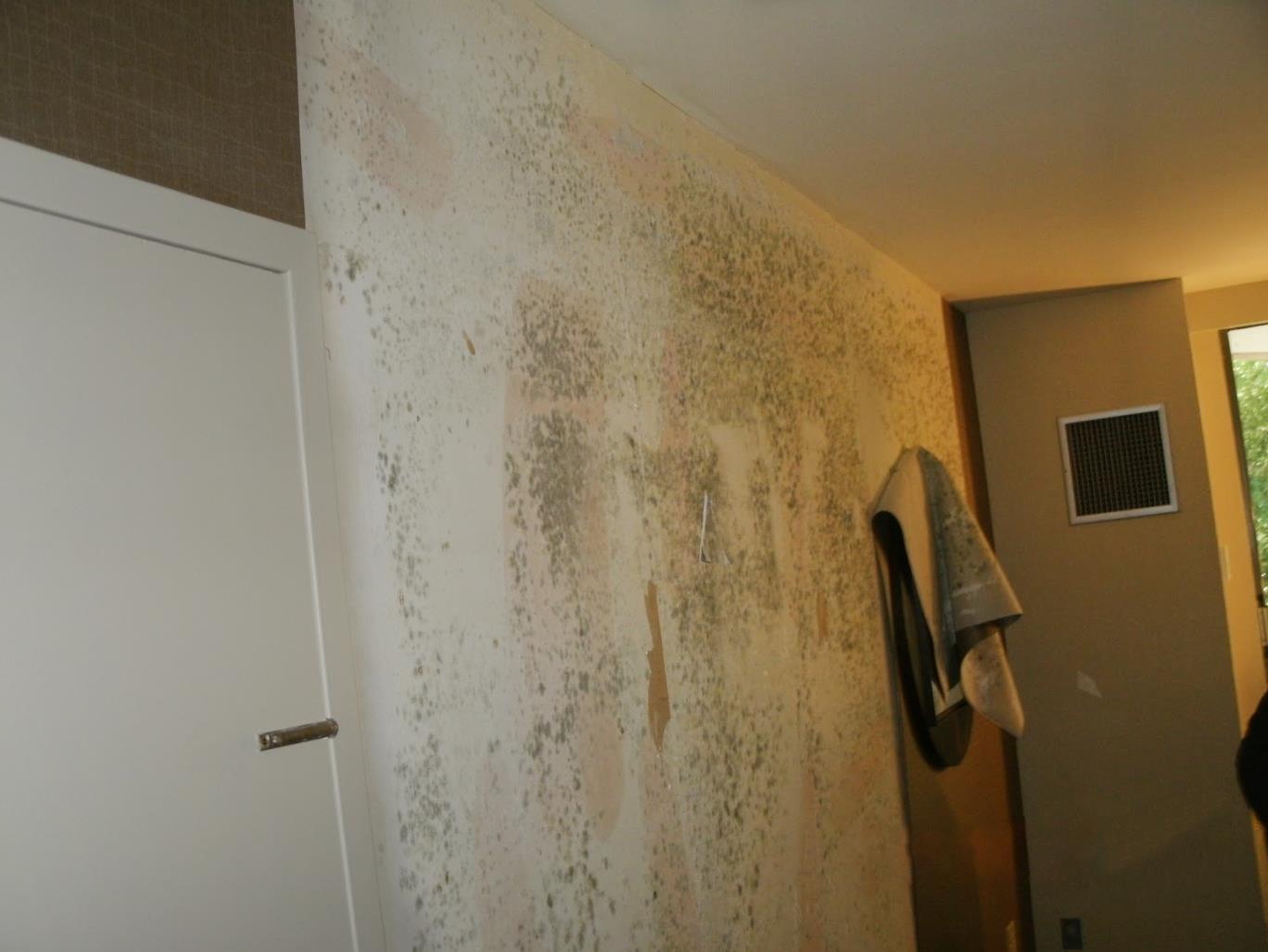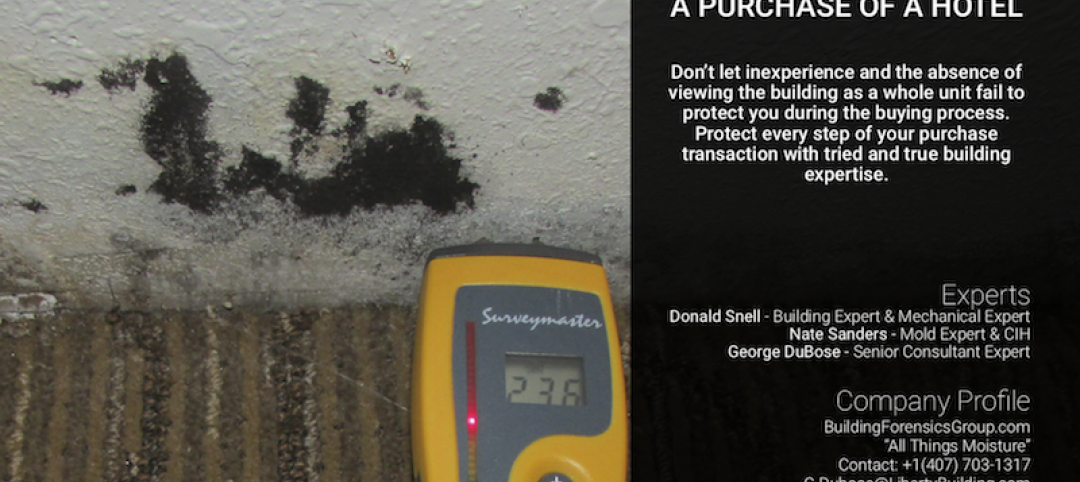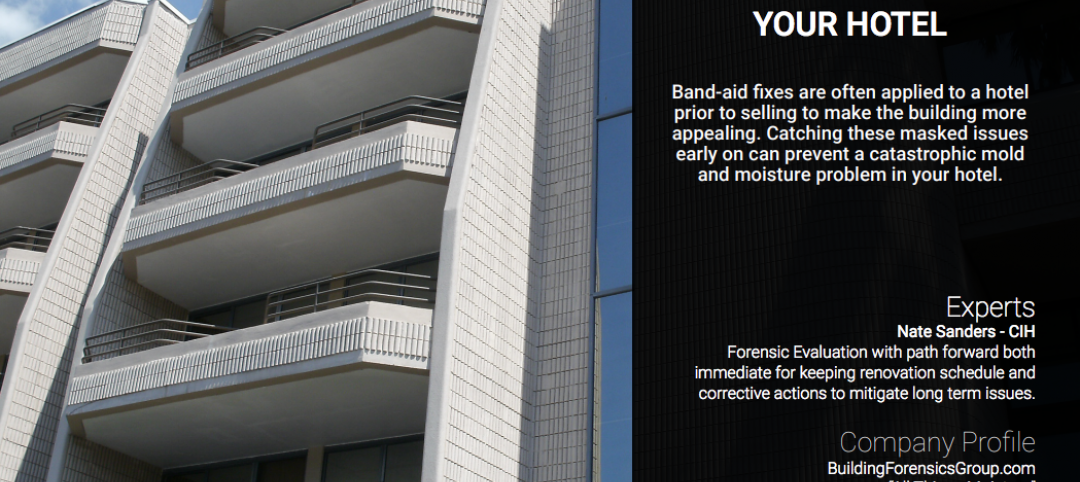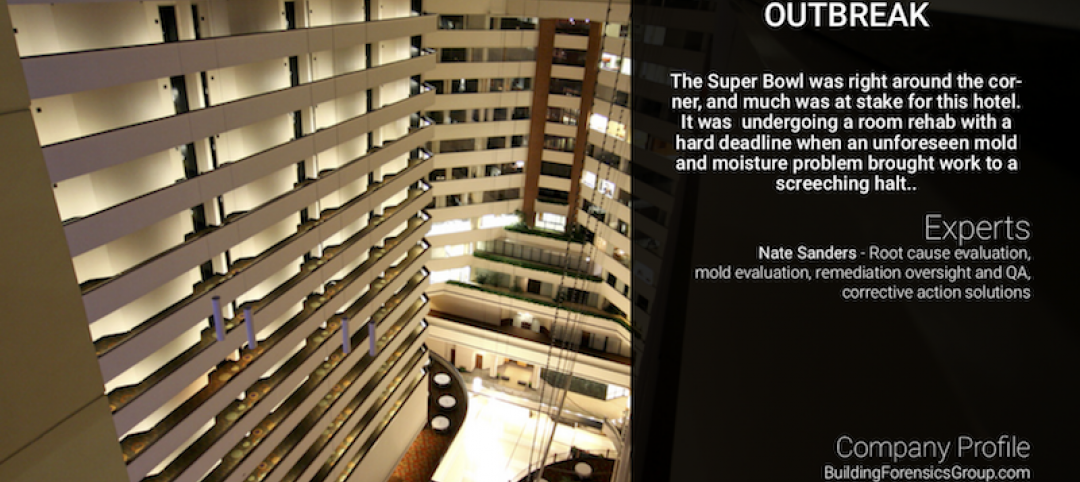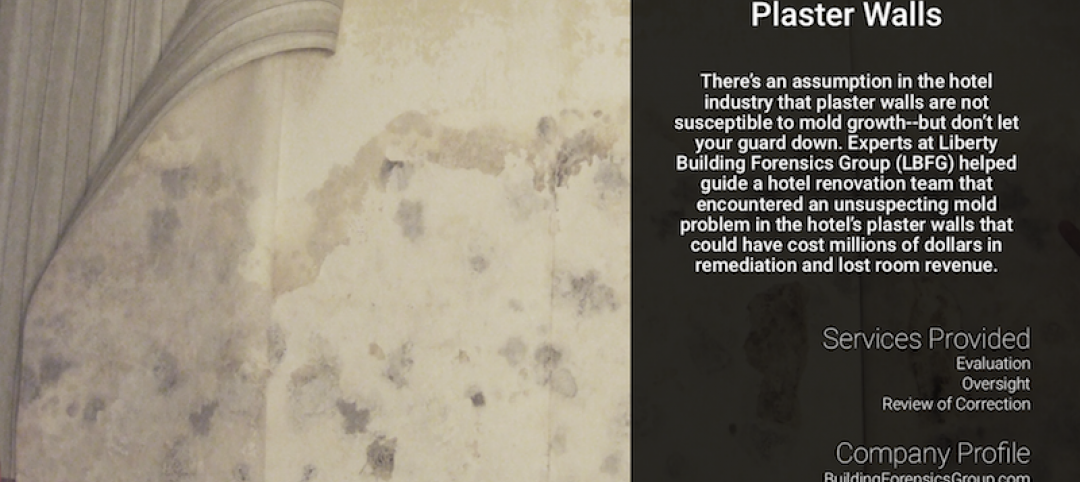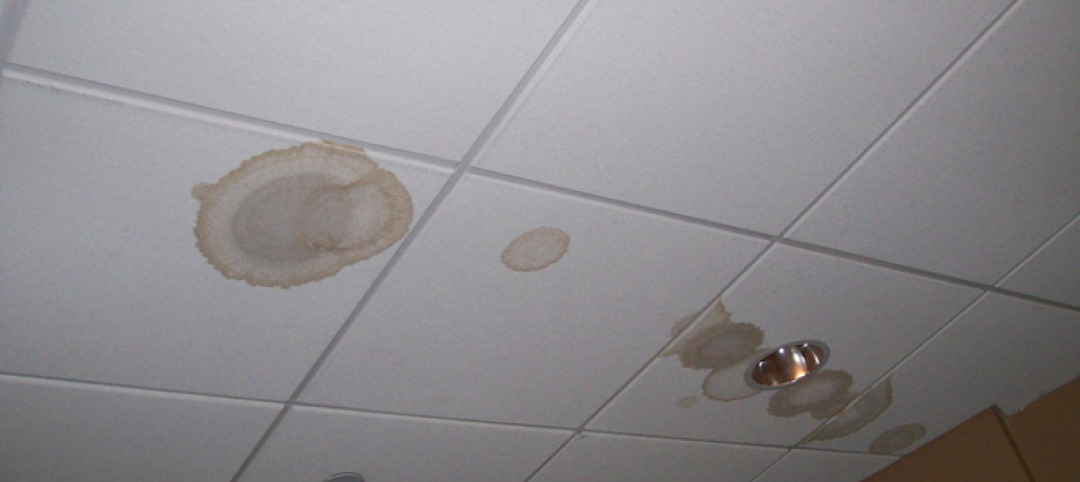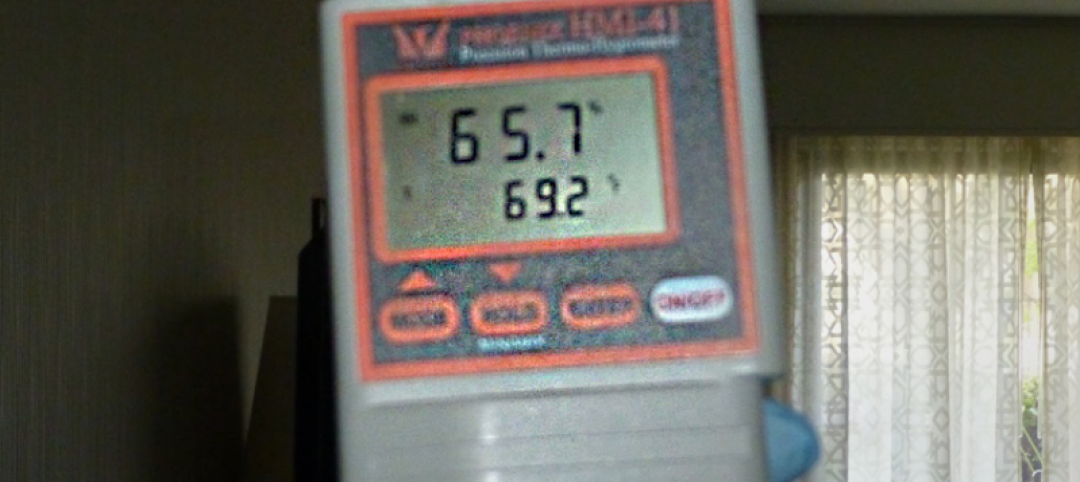Sign up for our free Aug. 2 webinar on “Hotel Renovations: More Than Just Minding the Dust”.
The time has come to perform that next renovation cycle for your hotel. You have successfully lined up your team of property staff, designers, and contractors. You are pleased with the fresh look proposed by the designers. Work is scheduled around your occupancy rate and the first wave of workers is let loose. You are ready for success - until the unexpected happens. Hidden moisture and mold damage disrupts your schedule, delays your reopening, requires redesign work, and increases the construction budget with a multitude of change orders.
If you had seen this coming, your entire renovation strategy would have been altered from the beginning. But could you have seen it coming? Most likely….if you had checked the essential building vital signs. A hotel owner/operator should assess these markers as the first step in any renovation to determine the potential for hidden moisture and mold damage. Understanding those vital signs, as well as the possible negative impact of brand standards, is critical for success.
Risks of Room Rehabs: Hotel Renovations Stymied by Moisture & Mold, and the Vital Signs that Were Missed
Our firm, Liberty Building Forensics Group (LBFG), has extensive experience with hotel renovations plagued with moisture and mold problems. Some of them occurred in hot, humid climates, while others have been in more temperate or even cold, dry climates. Most of these mold and moisture problems, including those in the following examples, were predictable and could have been prevented by evaluating the impact of proposed construction, especially with respect to the vital signs of the existing conditions.
One of the most important vital signs, especially in climate extremes such as hot and humid or cold and dry, is how well the building is breathing - in other words, what its mechanical pressurization is relative to the outdoors. Another companion vital sign in hot, humid climates is fever and sweats - that is, whether or not the relative humidity is under control.
Tampa Hotel
Prior to renovations, this Tampa hotel did not have a mold problem behind the vinyl wall covering (VWC). During renovation, the walls were stripped, skimmed with joint compound, and allowed to dry per the manufacturer’s recommendations before new VWC was installed. Mold started to grow behind the new VWC, however, while the renovations were still ongoing. The new VWC had to be torn down and replaced.
The mold problem was caused by an overlooked HVAC issue from a previous renovation, when the outdoor air grilles for the FCUs serving the rooms had been painted shut. The FCUs did not have to cool outdoor air loads so they shut down too quickly, before relative humidity in the rooms was reduced. This increased the time the joint compound took to dry, resulting in moisture trapped behind the VWC.
This problem could have been foreseen and prevented by both visual inspections of the HVAC systems and by measuring the vital signs of relative building pressurization and humidity prior to renovation. At the very least, checking the moisture content of the joint compound before applying VWC should have been performed.
D.C. Hotel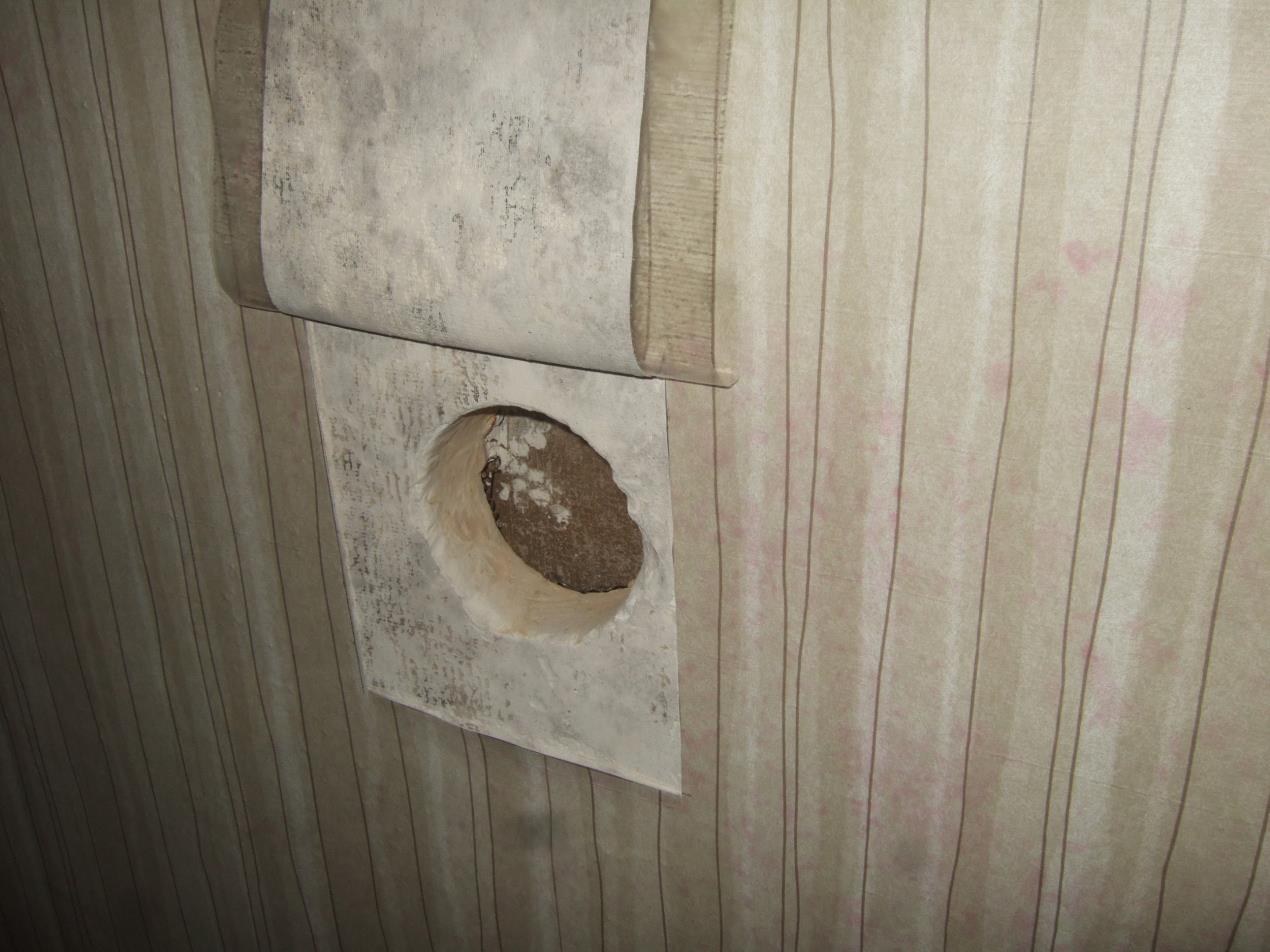 A hole cut from the corridor side of this solid plaster wall in a Washington, D.C. hotel shows guest bathtub tile backer board at the same location as the pink stains. The plaster was still wet at these locations, but not where the other side of the wall was painted.
A hole cut from the corridor side of this solid plaster wall in a Washington, D.C. hotel shows guest bathtub tile backer board at the same location as the pink stains. The plaster was still wet at these locations, but not where the other side of the wall was painted.
This existing Washington, D.C. hotel contained plaster corridor walls with VWC. During renovation, the plaster walls were stripped of the VWC, cleaned, repaired with plaster patching and skim coats, and allowed to dry before new VWC was installed. Subsequently, the VWC was discolored with pink stains and mold was found on the surfaces behind the stains, but only in specific corridor locations. The new VWC had to be torn down and replaced.
In this case, the problem was caused by overlooking the limited drying potential of the plaster wall and the subsequent lack of drying of the new plaster and VWC paste. Unlike the Tampa hotel, however, the mechanism was not HVAC-driven. The corridor walls were solid plaster (no cavity space). The pink stains and mold occurred in the corridor walls common to the guest room bathrooms, specifically opposite areas of bathtub tile.
The vapor resistance of the large wall tile prevented the drying of the plaster. Damage occurred where moisture in the new plaster was trapped by the tile and the VWC, both acting as vapor retarders. On wall sections where the room side of the wall was not tiled - below the tub line and above the dropped ceiling line - damage did not occur in the corridor. An analysis of the drying potential for the interior walls, as well as checking the moisture content before applying VWC, could have prevented the damage.
Southeast Asia Hotel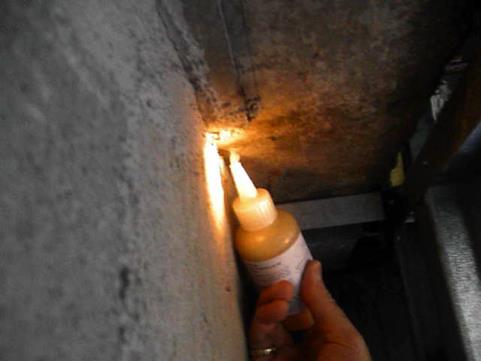 Qualitative testing of the exterior wall cavities using a smoke bottle confirmed what should have been obvious in a peer review of the Southeast Asia hotel construction drawings. The building was under negative pressure, drawing hot, humid outdoor air into the exterior wall cavities and causing mold growth. (Watch this video to see the smoke test: https://youtu.be/3HKiPFVthMw.)
Qualitative testing of the exterior wall cavities using a smoke bottle confirmed what should have been obvious in a peer review of the Southeast Asia hotel construction drawings. The building was under negative pressure, drawing hot, humid outdoor air into the exterior wall cavities and causing mold growth. (Watch this video to see the smoke test: https://youtu.be/3HKiPFVthMw.)
This high-rise hotel in Southeast Asia was undergoing a 2,000+-room soft goods renovation when significant mold growth was discovered in certain room walls due to air infiltration and moisture in bathrooms. Prior to the work, the room renovation team relied on TripAdvisor feedback and on an analysis of maintenance work orders to see if there was a systemic mold problem in the rooms. This assessment, which concluded there was only an “inside-the-room humidity problem,” missed the mold problem. Recovery of costs was pursued from the property insurance carrier and the building’s landlord.
The hotel missed the mold problem by relying only on work orders and guest feedback. Mold growth was hidden in the walls and was thus missed by these assessment methods. Additionally, there was no interaction between the facade engineer and the HVAC engineer. Mold inside the walls could have been discovered before the start of renovation if a detailed mold survey had been done, as well as a professional assessment of the HVAC and building envelope systems and how they interact with each other.
Indianapolis Hotel
Renovations to this Indianapolis hotel were being fast-tracked to take advantage of Super Bowl XLVI. Before long, however, the cost of renovations increased by 20% due to mold problems which were a result of overlooking an HVAC operational problem.
Mechanically-induced pressurization caused this mold problem. The HVAC control system included a night setback that reduced the makeup air while allowing the toilet exhausts to run continuously. The resultant influx of humid outdoor air caused mold growth. This problem would have been identified beforehand with a review of the HVAC system operation and pressure mapping.
How Do You Prevent Mold and Moisture Problems During Renovation Work?
Just as a doctor reviews a patient’s vital signs before recommending or beginning a procedure, hotel owners/operators and their design/construction team need to check a building’s vital signs before design/rehab to avoid moisture and mold problems. The building failures in the case studies presented above, as well as in many other hotels LBFG has investigated, would have been predictable and preventable if the vital signs had been checked, assessed, and understood through a process of field investigation and focused peer review of the proposed scope of work and impact of new brand standards.
Below are questions to ask and vital signs to examine before you begin the next renovation on your hotel:
- Breathing -- How well is the building breathing? Measure relative pressurization and air flow direction.
- Internal temperature -- Are there fevers or sweats? Is the indoor RH within acceptable limits?
- Heartbeat -- Is the HVAC control system doing its job in maintaining temperature, relative humidity, and pressurization, 24/7?
- Rashes and bruises -- Are building materials, both interior and exterior, free from signs of discoloration?
- Water retention -- Is there moisture in the walls, ceilings, floors, etc.?
- Fractures -- Are floors uneven, sagging, or springy (or walls bulging or cracking), suggesting water damage to the substrate?
- Bleeding -- Is there any external bleeding (storm water intrusion) and/or internal bleeding (pipe leaks)?
- Bad breath -- Are musty odors noticeable? Have guests complained? Do maintenance logs reveal a pattern of problems?
- Patient history -- What repairs have been made in the past? What was the effect of previous (and new) brand standards?
About the Author
Richard Scott-AIA, NCARB, LEED AP, a Senior Forensic Architect at LBFG with more than 35 years’ architectural experience and an expert in building envelopes, has conducted more than 500 forensic investigations and has helped solve some of the most complicated mold and moisture failures in the world.
LBFG has provided mold and moisture diagnoses and solutions for buildings to owners, contractors, and developers worldwide. The firm has project experience in the U.S., Canada, Mexico, the Caribbean, Central America, the Middle East, Southeast Asia, and Europe. Contact us at g.dubose@libertybuilding.com or by phone at 407/467-5518. Visit our website at www.buildingforensics.com.
More from Author
Richard Scott-AIA, NCARB, LEED AP of Liberty Building Forensics Group | Mar 1, 2019
How to protect yourself from hidden mold problems during a purchase of a hotel
Don’t let inexperience and the absence of viewing the building as a whole unit fail to protect you during the buying process. Protect every step of your purchase transaction with tried and true building expertise.
Richard Scott-AIA, NCARB, LEED AP of Liberty Building Forensics Group | Feb 7, 2019
Don't let a simple band-aid fix cause a mold problem in your hotel
Band-aid fixes are often applied to a hotel prior to selling to make the building more appealing. Catching these masked issues early on can prevent a catastrophic mold and moisture problem in your hotel.
Richard Scott-AIA, NCARB, LEED AP of Liberty Building Forensics Group | Jan 28, 2019
Hotel renovation for the Super Bowl halted due to mold outbreak
The Super Bowl was right around the corner, and much was at stake for this hotel. It was undergoing a room rehab with a hard deadline when an unforeseen mold and moisture problem brought work to a screeching halt.
Richard Scott-AIA, NCARB, LEED AP of Liberty Building Forensics Group | Jan 21, 2019
Hotel renovation threatened due to unexpected mold on plaster walls
Mold growth is not seen as frequently on plaster walls as it is on gypsum wallboard, primarily because there are no nutrients to support mold growth.
Richard Scott-AIA, NCARB, LEED AP of Liberty Building Forensics Group | Jan 14, 2019
Air barriers: Expectations vs. reality
When new building code requirements require high performance and innovation incentives, such as those found in green building rating systems, significant confusion and some building failure will ensue.
Richard Scott-AIA, NCARB, LEED AP of Liberty Building Forensics Group | Nov 20, 2018
Monitor these 9 vital signs to avoid widespread mold & moisture problems in your building
Many building owners and operators rely solely on a property condition assessment (PCA) to determine if they have a problem.

